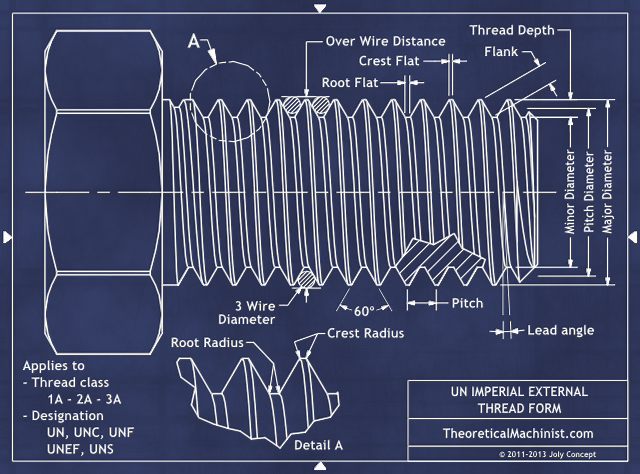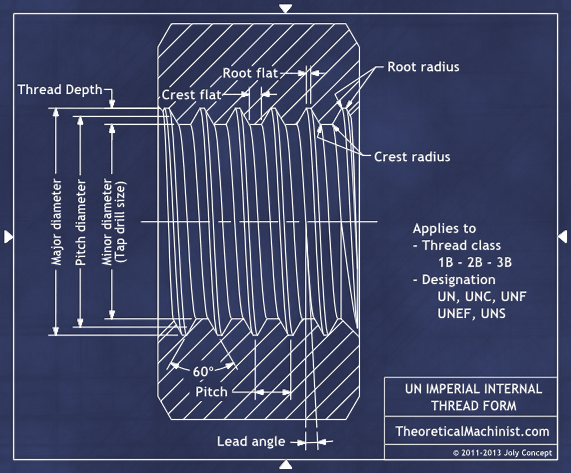

Glossary
- Thread calculator:
- All calculated results are based on; Basic outside diameter, number of threads per
inch, series designation and class tolerances.
- The algorithms used for this calculator are based on the "my" best interpretation
of the ANSI/ASME B1.1-1989 specification.
- Imperial UN: (Imperial Unified National thread form)
- A standard that describes the shape of an internal or external thread using imperial
inch dimensions. Making a thread that follow these specifications will ensure that
it will work with threaded holes or shafts made by other manufacturers that follow
these common specs.
- Outside diameter:
- This is the biggest diameter of the helical portion of a thread. The biggest external
diameter of a Screw or the biggest internal diameter of a threaded hole.
-
NOTE: The size of the hexagon of a bolt or nut has no relevance when defining
a thread size.
- TPI: (Threads per inch)
- The number of thread, or "V"s along a one inch length which in turns, defines the
size of the "V" shape of the helical portion of a thread.
-
NOTE: If the length of the threaded portion of a screw or threaded hole is
shorter or longer than one inch, the size of the "V" shape is still defined by the
number of thread that would fit along a one inch length.
- thread series designation: (UN, UNC, UNF, UNEF, UNS)
- The thread series is generally relative to the outside diameter of the screw. 20
threads per inch on a 1/4" diameter screw is considered coarse: 1/4-20 UNC. On a
3/4" diameter screw, 20 threads per inch is considered extra-fine: 3/4-20 UNEF.
It also plays a role in determining the length of engagement.
- UN: standard series thread.
- UNC: coarse thread series.
- UNF: fine thread series.
- UNEF: extra-fine thread series.
- UNS: special thread series.
- UNR: standard series thread with rounded root. (This series is
not supported)
- UNJ: high stress series thread with large rounded root on external
screw thread (This series is not supported)
- Class tolerances: (If unsure, use class 2A for external or 2B for internal)
- Tolerance classes 1A, 2A and 3A apply to external thread
- Tolerance classes 1B, 2B and 3B apply to internal threads.
- The class tolerance determines the size of the gap between the pitch diameters of
the internal and external thread. class 1A and 1B have the largest gap to class
3A and 3B which have the smallest gap. Most commonly used are the classes 2A and
2B. the tolerance classes 2A and 2B are within classes 1A and 1B.
- No. of starts:
- This is the quantity of helical entries along the length of the screws. Most screws
have only 1 but a thread with multiple starts advance a greater distance for each
turn.
- Definition:
- This is the standard way of defining a screw thread. example: 7/8-18 UNS 2A 2 starts
- 7/8: Basic outside diameter. Can be a fractions, screw number
#0 - #12, or a decimal number.
- 18: Threads per inch. Can be a decimal number such as 4.5 threads
per inch.
- UNS: Thread series designation.
- 2A: Class tolerance. determines if it is an external or internal
thread.
- 2 starts: Number of starts. It does not need to be specified for
1 start threads.
- Diameters:
- Major diameter: the maximum and minimum sizes of the outside diameter of a screw
- Pitch diameter: the Maximum and minimum sizes where the 1/2 Pitch intersects within
the "V" shape of the screw thread. (this is the most important dimension of a thread)
- Minor diameter: The maximum and minimum sizes of the smallest diameter of the screw
threads
- Over wires distance: these are the maximum and minimum distances if using 3 wires
of the same size to measure the dimension close to the pitch diameter of an external
thread.
- Wire Diameters: Diameter of the wires used to measure the dimension close to the
pitch diameter the external screw thread.
- Tolerances:
- Allowance: Fundamental deviation of the basic size, applies only to 1A and 2A external
classes
- Major/Pitch/Minor diameters: The difference between the maximum and minimum diameters.
- Length of engagement: Basic length of thread engagement that is defined by a combination
of thread series, pitch and diameter. (Not to be confused with the length of a thread)
- V-Shape:
- Pitch: The distance between 2 adjacent "V" shapes.
- Real pitch: The distance between "V"s after following a helical path around the
diameter of the screw.
- Crest flat: Maximum and minimum size of the flat at tip of each thread pitch.
- Crest radius max: The maximum radius that will fit on the minimum crest size.
- Root flat: Maximum and minimum flats at bottom of "V" that will allow the greatest
range.
- Root radius: Maximum and minimum radius that will allow greatest range.
- Thread depth: Maximum and minimum thread depth that will allow greatest range.
- Flank length: Maximum and minimum flank legth that will allow greatest range.
- Lead angle:
- Major/Pitch/Minor diameters: The resulting angle if you were to unwrap the helix
at one of these diameters.
Last Updated: 13 February 2015